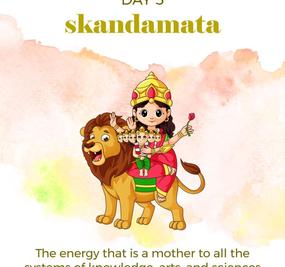Navaratri is a time when all the branches of knowledge are presented – vedic mantras, music, dance and other arts. It is a time for rejuvenation and reaffirming a commitment to knowledge. The vedic mantras originate in a vast collection of ancient knowledge known as the Vedas. This tradition of knowledge, which goes back thousands of years, is praised all over the world for its depth and understanding. The scriptures which we still have today, offer detailed insight into a wide range of subjects and sciences covering all aspects of life, ranging from medical science, astronomy, mathematics, dance to statecraft and many more.
The Nature of Mantras
Every sound has a certain effect on the consciousness. For example, when we hear some pleasant music, it calms us. Other types of music make us get up and dance – even without knowing the meaning of the lyrics! In the same way, the ancient sages, called Rishis, going deep in meditation, researched the effect of different vibrations on consciousness. Assimilating these different sounds, perceived in deep meditation, the Rishis came up with mantras, which have a specific impact on consciousness. During Navaratri, various homas are performed and mantras are chanted which have a harmonizing impact on the consciousness, as the Rishis described in the Vedas.
In fact, in our modern science today, the theory of quantum mechanics claims that particles act as waves of probability. In the words of scientist Niels Bohr, ‘everything we call real is made of things that cannot be regarded as real’. As science progresses, we find out many things that seemed magical a few years back become obvious with an expanded understanding. Just because one does not know how a mobile phone works, does not mean one cannot use it. In the same way, though science has not yet discovered how mantras work, we can no longer doubt the impact that mantras have on the environment and consciousness.
Ancient Knowledge is Accurate Even Today
These seer-scientists were called ‘seers,’ because they ‘saw’ the knowledge. They did this by going into deep meditation and quieting the mind. In such a state, the Rishis could understand the characteristics of the forces of nature. Their calculations and mathematical methods are accurate even today. Thousands of years ago these seer-scientists had already described many things, which Western science has discovered only in the last few centuries – an example being the description of molecules and atoms. Observing nature, the Rishis could describe the energy or consciousness that is pervading this whole creation. After passing on their knowledge orally for generations, it was finally written down in four main scriptures of the Vedas.
Structure of The Vedas
The Vedas were written in an ancient form of Sanskrit, and the word ‘Veda’ itself comes from the Sanskrit root ‘vid,’ which means ‘to know.’ There are four Vedas, the Rig Veda, Sama Veda, Yajur Veda, and the Atharva Veda.Each Veda is subsequently made up into four parts. The first, Samhita, are verses or hymns, which form the base, like a textbook. The Brahmana gives instruction on how to apply the knowledge, such as how to perform rituals. Aranyaka illustrates the deeper meaning behind the rituals being performed. Upanishad means ‘sitting close’ the teacher to receive instruction. This is where the Vedanta (literally a ‘culmination or end of knowledge’) is expounded: the knowledge of the ultimate truth of existence.
There are six branches of the Vedas as well, such as the sciences of logic, the planetary positions and their movements, grammar, and the phonetics that need to be mastered first in order to be able to study the Vedas correctly. The Vedas are a storehouse of knowledge about nature “from the microcosm to the macrocosm,” says Sri Sri Ravi Shankar.
Paravidya and Aparavidya: The Nature of Education
The nature of education involves knowing and through wanting to know, more can be learned. ‘Vidya’ is a Sanskrit word meaning education or knowledge. There is knowledge that one knows by experience, just as one knows the taste of a pineapple. Trying to describe the taste of a pineapple to someone who has never tasted it, or describing the way wading through water feels to one who has never experienced it is nearly impossible. This is the way with paravidya, meaning ‘knowledge of that which is beyond (para).’ Beyond any knowledge that can be measured and taught, this type of knowledge just has to be experienced. An enlightened Guru gives us a glimpse of this type of knowledge, through the Guru’s grace.
The other type of knowledge is aparavidya and this can be pondered upon and taught to others. We all have asked ourselves these questions: Where have I come from? How did life on this planet begin? How did the universe come into being? Over 5,000 years ago, the Rishis, the authors of the Vedas, also pondered these same questions. Through interacting and by a questioning nature, in deep meditation, the Rishis came to an understanding of the origins and nature of the cosmos.
The Tradition Continues
This tradition of scientific inquiry found in the Vedas is alive even today. Sri Sri Ravi Shankar says that our modern scientists are the modern-day Rishis, and like the sages of thousands of years ago, they also explore the universe. Sri Sri says, “All are to be honored, whether ancient or modern.”
As we continue to revive the Vedas, modern science has taken notice of the ancient Vedic knowledge with a sense of reverence. “Today’s quantum physics discoveries are startling,” says Sri Sri. “There is so much similarity to Vedic knowledge. Dr. Hans-Peter Dürr, the physicist has told me that whenever he is giving a lecture on quantum physics, he feels as if he is speaking on Vedanta. The whole universe is made up of one substance. Ancient Rishis and modern physicists both say the same thing,” notes Sri Sri.














